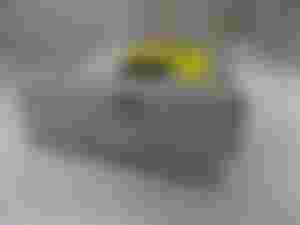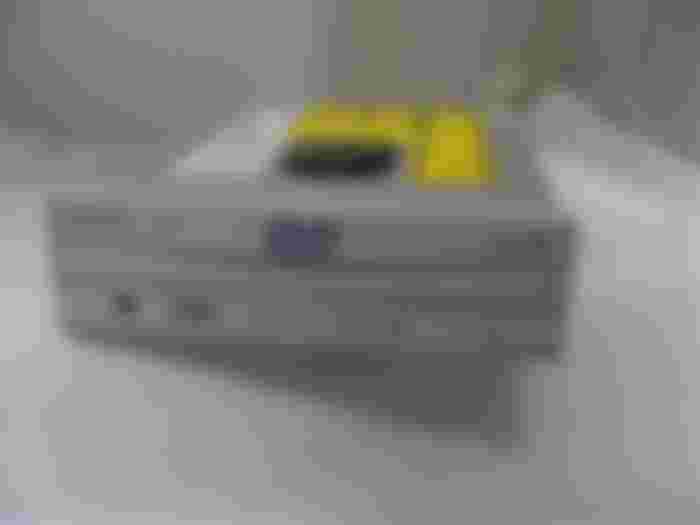Vintage DVD burners are something you probably don't even know about, especially if you are a teenager, or if you are in your early 20's. Optical storage medium formats became obsolete, and people don't use CD or DVD discs any more. The Blu-Ray format never really caught up. This article will explain how the things went in the early 2000's, which resulted the rapid development of the DVD technology. It must be noted that some of the events are in overlap with each other, so even if i try to explain it in time order, some of these events actually happened parallel to each other, and the events always took multiple years to unfold.

CDs became mainstream
Before we discuss vintage DVD burners, we must observe the market before that era. CD drives and CD discs was super expensive in the mid 90's. As the technology became more wide-spread, the prices started to drop. In 1998, the price of a blank CD-R disc was about $3-4, and a 2x CD burner was about $300. A regular CD drive not capable of burning was around $80. I was not able to afford to have a CD burner, so i only got a CD drive and i got only a few CDs.
CD becomes too small
In 1997-1998 a generic hard drive was about 300-400 MByte. The size of a CD in comparison, is 700 MByte. Some computers only had 20-40 MByte hard drives, such as the older 386 computers, which were still popular in less rich countries. The things have however changed in the early 2000s, when 1-10 GByte drives became widely and cheaply available. As the CD is only capable to carry 700 MByte of data by default, the industry invented other methods of carrying the data.
Mobile racks
Mobile racks are hard disk racks. They are standardized, and compatible with each other, regardless of the manufacturer (or at least, they should be). One part of the rack goes into a computer, and you put the hard drive into the internal part. Then people just put them into their backpacks, and bring their data with them-self. This was more convenient, because this technology required no special burner hardware, and it was basically just a plastic clip with a few cables, and it worked for years before it broke down.

CD becoming obsolete
CD was still fine for audio material, but it quickly became small for regular data. Instead of using optical discs, people switched the mobile racks, and CD was used as a platform only for audio CD, PC video games, and in the form of driver CD-s for computers. The price of CD burners rapidly fell, second hand shops became full of few dollars worth of optical drives and burners, so suddenly everyone was able to afford them.
CD warez: exchange of illegal materials
As the masses was able to access the CD technology, which became very cheap in the early 2000s, people started to use CD as a platform to store and sell illegal material on. The publishers and developers of software and movies started to form alliances, which almost acted as a police, and sometimes worked with cooperation with the police. Nowadays this probably could not even be imaginable, but politicians and the police simply violated the constitutional rights of citizens to pull this out, causing quick disintegration of the trust in the state as a whole, making publishers a target of hackers, and indeed rendering their acts as national security risk.
Consolidation
After a while, in most countries, the state gave up. They have decriminalized uploading, downloading and storing copyrighted material for private purpose. This however, resulted no further boom of the adoption of the CD technology, as the regular hard disk sizes quickly grew up to 30-40 GByte, and people were just able to put 2 or 3 to their computers for cheap. A computer like this, was able to store the contents of hundreds of CDs. A new format was needed, and people needed it fast.
The arrival of the DVD
The standard was designed and released in the late 90's, but the actual shipment of the first real mass content on DVD dates around 2001-2002. There were attempts to ship movies and DVD players in the late 90s, but the masses had no awareness of this technology before the 2000s. As the DVD format was already available in the early 2000s, parallel with the CD, people should have bought a separate DVD drive to read DVD discs. A dvd drive was also able to read CD discs, and later on, combo drives, allowing to burn CD-R discs and able to read DVD discs were also appeared. As a DVD is able to hold 4,4 GByte of data, it quickly became a widespread format to store movies and video games.
The first generation of vintage DVD burners appear
Initially, they was two type of DVD discs. One was the DVD-ROM, which was a read-only format for pressed DVD material. The second was called DVD-RAM. The DVD-RAM was a read and write format. Operating systems was able to format them and write data to them, just with drag and drop. It worked similarly like a giant multiple gigabyte capacity floppy disk. The two formats were however not compatible, so generic DVD drives was not able to read the contents of a DVD-RAM disc.

DVD-RAM fails the market
There was other reasons of the failure: the DVD-RAM drives used caddy loading mechanism. The DVD was in a protective plastic box, which the user was able to open and take out the disc if he wanted to do so, but regular DVD drives didn't used this mechanism. This made the two format inconvenient to use together even if a drive supported both of the format.
Panasonic, Hitachi and Toshiba were the only manufacturer to develop and release DVD-RAM drives in these early days of the format. The price of these drives were multiple 1000s of dollars, and as the format didn't caught up, this resulted the total demise of this first generation of drives within one or two years.
A new solution and new approach
A solution compatible with the regular DVD-ROM was needed, and this arrived in the shape of recordable DVD-R discs, and later on, the rewriteable DVD-RW discs have been arrived as well. The first mass-produced DVD-R discs were about $30 when they was initially released, this was still high, but was low enough for some people to buy, and produce the necessary number of sales for the technology development.
A format war begins
There was a disagreement of the developers and corporations about the new recordable format. The original format specifications were significantly different regarding the CD specifications of the track spiral information on the disc surface. This had a role in guiding the laser as it reads through the data spiral on the surface. The opposing fraction of developers wanted the spiral information to be more similar to a CD, thus resulting a little bit cheaper manufacturing costs.
The DVD-R and DVD+R borns
The fraction with the new type of spiral came up with the DVD-R standard, the rest of the developers came up with the DVD+R standard. The two format entered into a war with each other. The two separate group was not able to came to a conclusion, and even till nowadays, you can find DVD-R and DVD+R discs on the market, as the two format was not able to defeat the another one ever since.
The second generation of DVD burners
To write the new DVD-R and DVD+R discs, new burners were needed. This time, the manufacturers previously focusing on cheap and durable OEM CD burners, were tought, its time to enter the market. As LG, Ricoh, Plextor, Toshiba, Pioneer already developed a combo DVD reader-CD burner drive by the late 2001, they quickly begin to work on their new real DVD burner. Pioneer already had a desktop DVD player with DVD recording functions, shipped from 2000 january. One of the first PC burners appearing on the market was the HP-dvd100i. NEC, Teac, Sony, Asus, and BENQ also joined the competition with their drives. Even corporations like TDK, Mitsumi and Iomega started to work on their own DVD burners. By 2002, all major players have released their first generation of DVD burners.
Testing the second generation of DVD burners
These drives were not manufactured in large quantities, and they was relatively expensive, but not unpayable. Very few drives survived till this day from this generation, but i was able to gather some of them. So instead of testing them one by one, i will showcase the ones i had/have, to show a generic insight about the burners of this era.
NEC ND-1300A
The NEC ND-1300A was manufactured in 2003, its one of the first cheap mass-burners available. I bought this drive for myself to christmas in 2004. The drive came in its original box. The box said, its a 2,4x burner. I thought, oh, so its a 2x and 4x burner! Well, i was wrong, because it was actually a 2.4x speed burner instead, but it does not matters, as the burner was only $20, and it supported both the + and the - format, at least on paper.

The drive indeed was able to burn some DVD+R discs at 4x on paper, but i have never seen any disc which this was able to burn faster than 2.4x. The drive was very heavy, the design was white and moderate. It was able to burn discs at 2x and 2.4x for a while. I have used the drive for more than a year, when the first major problems arised.
Incompatibility issues of the second generation
After buying a new set of DVD cake from the brand i was used to burn, i just found out that the Disc manufacturer changed the technology somehow. And my drive was not able to write these discs any more. I have searched the internet for a solution. And indeed, i found the solution, it was called a firmware upgrade. Luckily, after upgrading the firmware, the ND-1300A was able to burn these discs. Until i have bought another cake from this same brand. Then, i faced the same issue, i was not able to burn the discs. And, worse, it was no newer firmware upgrades. I was not able to burn anything with this drive any more.
Buying another second-gen drive
Someone offered to sell me an LG GSA-4082B for $30 with a few old hard disks, and he also gave an extra slot-in DVD reader drive as a present. The ND-1300A silently died afterwards while it was sitting unused, so i had to throw it away. The LG GSA-4082B was designed in 2003 and it was sold till 2004 june. The 4082B had an identical hardware to its predecessor, the 4081B, except for the head and the firmware itself. It was advertised to be an 8x DVD burner. Of course, this was not an 8x burner. It could not burn anything faster than 4x even if you throw it down from a greased redcliff in tailwind. There was no DVD-R discs mass produced for 8x burning at that time anyway, LG basically hacked the newly released Ridisc branded disks into its firmware to support 8x speed to be legally able to sell it as a 8x burner. The 4082B also can read and write the archaic DVD-RAM standard, which makes it a very special drive.

The saga of the LG GSA-4082B
The 4082B offered a wonderful performance - if we talk about writing. The 4082B was able to burn vintage CD-RW discs, it was able to burn CD discs at 4x and 8x, and to burn DVD-R discs at 2x or 4x, depending on the branding. The 4082B is a slow drive, it is rotating the CD and DVD discs very slowly and silently, so you dont have to worry your medium to be damaged from the large speed. The DVD discs burned with this drive are playable in family DVD players. The CDs burned with this are playable in car audio CD players, and in Hi-Fi towers as well.
Info on CLV burners
The second generation of DVD burners are CLV burners. CLV means constant linear velocity. This means the disk surface always moves in front of the laser with the same speed all across the disk while burning the disc. The disk rotation speed is always regulated according to what ecsact point the disc is being burned. This only allows for 4x burning, so of course the boldly claimed 8x burning on the 4082b would not be possible, as both the previously discussed NEC and LG burners are strongly CLV only.
More info on the 4082B
The LG GSA-4082B is indeed just a burner. Of course, it can read discs - it just not intended to be used like that. Just like the CD burners from LG, the 4081B and 4082B has petty slow seeking times. The seeking noise is similar to almost like a floppy disc, and barely faster than that. The GSA-4082B will spend about 20 seconds to spin and detect disc inserted into the drive. This makes it non-ideal to be used as a reader. The read speed is always low, only 32x max when reading a CD, and 8-12x when reading a DVD. Some drives from this era are faster readers, like even the previous NEC is much better when it comes to reading, but its much worse in writing as we can seen. The 4082B is advertised to be compatible with DVD+R and DVD+RW discs, however, its unable to write or even read the DVD+RW discs i have tried in it, and it only burns DVD-RW at 2x or 2,4x if you are really lucky.
CLV vs CAV
The drives discussed above are CLV burners. This means that they needed a giant FPGA chip on a giant PCB circuit inside them, to control the motor to spin speed precisely. However, speeds above 4x are basically impossible to actually achieved with this burners. Therefore the industry agreed to switch to CAV. CAV means constant angular velocity. This means the disc always spins at a given RPM and the laser power is adjusted on the fly when burning the disc. This makes it possible to manufacture cheaper burners with far less electronic material, it also makes these drives to be smaller and be more lightweight. There is a variation of CAV called ZCLV, which is actually a CAV strategy, and despite of its name, it has nothing much to do with CLV.
The third generation of burners
The new CAV burners were released in 2004. By 2004 June, most of the manufacturers sold out their old CLV burners. Some brands like LG and Pioneer released one or two models in 2004 with still keeping the real CLV electronics inside, but being able to do the new CAV standard as well, such as the LG GSA-4120B and the BENQ DW1620. The result was basically near useless and incompatible design which were unable to detect, burn both older and newer discs, and they quickly died even if they just sitting in idle - these drives were quickly removed from the market, ending the era of CLV burners forever.
From 4x to 16x within days
Sadly, most of the manufacturers stopped supporting the old CLV burners with firmware upgrades as well. New discs were optimized for 16x DVD burning as well. This basically meant the death sentence for the second generation of drives. Most people threw the second generation of burners away, so currently its very hard to find one. This is a big problem, because vintage CD and DVD apparatus, vintage laptops with old DVD drives will not read most of the discs burned in CAV burners. CD burners also switched to CAV much earlier, so people used the early DVD burners to burn audio CD for their cars. With the disappearance of the second generation of DVD burners, its hard to keep alive vintage computer apparatus as well.
Third generation overtakes
Currently, all DVD burners for laptops and desktops belong to the third generation. Basically everything that was released after 2004 july, is a CAV driver. Modern DVD drives can burn at 16x CAV speeds, the internal ring of the DVD is usually burned at 4x, the center about 12x and the edge of the disc reaches 16x, or sometimes more. These discs can be read in modern apparatus, such as in other post-2004 devices, but they can have issues with older hardware.
CLV burning with modern CAV burners
There is only a couple of modern CAV burners supporting CLV burning. There is no dedicated electric circuitry available in modern drives to indeed do a real CLV rotation speed control, so they simulating the CLV with a very precise CAV algorithm and laser power control. This does not works in reality, and the only ,,modern'' burner that can do this almost properly, is the Optiarc AD-7261S burner. Which is also almost 8 years old, so there is a slim chance to buy such a drive nowadays.
Operate a second-generation or a first-generation DVD burner
The first generation DVD-RAM drives usually uses the SCSI or IDE connector. These will need a PCI or PCI-E SCSI adapter. The second generation of drives use the IDE connector. If you want to operate an old DVD burner in a modern computer, you will have to buy an internal PCI card with IDE controller. Some modern PC have no PCI slot, in that situation, you need a SATA to IDE adapter. Compatibility with modern disc can be an issue, so even if the Disc will be writable in your drive, do not expect more than 2x burning speed, which will need about 40 minutes to fully burn a DVD-R.
Longevity of second-gen DVD-R
I have thrown out the DVD-R discs i have burned in the previous decades. I have destroyed the ones which had private data, and just throw out a lot with random movies. Those discs was burned mostly from 2004 to 2010. It had various brands, good and bad quality, with the branding of Maxell, Ritek, BenQ, Traxdata, Memorex, Ridisc, with various MID's such as CMC, MBI, Ritek, and so on. There was difference in what brands what old drives was willing to read. However, there was no difference between the manufacturers and the brands in quality. The ratio was only about one per 20 disc being damaged. If there was a damage, it was always only a minor read error in one of the files, but the error was always only one or two sectors. So we can say that old DVD-R discs was/still is a good way to store your data.
Summary
To sum up, there was total three era of DVD burners.
The first generation of DVD burners was the era of DVD-RAM burners, which have ended in 2001 (speed: 2-3x).
The second generation of DVD burners began in 2001 and ended in 2004 june. Some of them is backwards-compatible with DVD-RAM. (speed: 2-4x).
The third generation began in the early 2004, and this is also the current era of DVD burners. (speed: 16-24x).
The history of DVD drives is quite under-discussed, compared to vintage graphics cards and processors, meanwhile it is just as exciting. This is a new area for the retro collectors to reconstruct from old information, which is becoming more and more hard to dig up.

...and you will also help the author collect more tips.





I haven't used a DVD reader since 2010. I guess I'm a Zoomer 😂